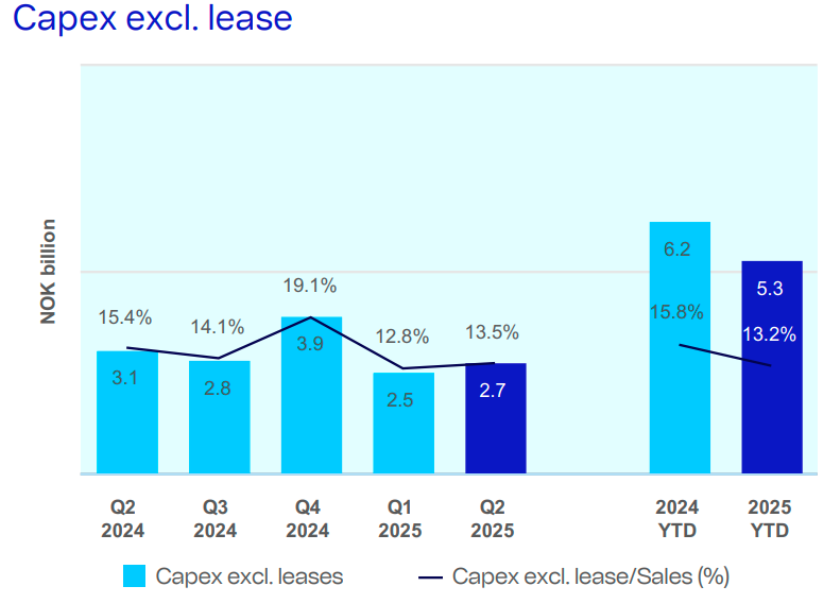Telecom operator Telenor has revealed its financial performance – revenue, subscribers, Capex, ARPU, strategies – during the second-quarter of 2025.

Revenue
Telenor has reported revenues of NOK 20.3 billion in the second quarter of 2025, reflecting a 1.9 percent increase from the same period last year. Service revenues rose to NOK 16.5 billion, marking a 1.3 percent increase. The Nordic region remained the primary growth driver, supported by a 3.7 percent organic rise in service revenues and a 5.6 percent increase in mobile services, backed by ARPU growth across all markets and subscriber gains in Sweden, Denmark, and Finland.
In contrast, Asia recorded 0.7 percent organic growth in service revenues, with strong performance in Pakistan partially offsetting a continued decline in Bangladesh due to challenging market conditions. Additional revenue gains came from increased wholesale business in Norway, which contributed an extra NOK 179 million, largely due to the full-quarter impact of a national roaming agreement with Lyse Tele (Ice).
“In Asia, we were encouraged by good execution in Grameenphone, both commercially and in terms of cost efficiency despite the continued challenging market situation in Bangladesh,” Benedicte Schilbred Fasmer, President & CEO Telenor Group, said.
“Telenor Pakistan continued its streak of gold-star operational performance, and True secured new spectrum in an auction that we believe reinforces a sound industry structure and regulatory framework in Thailand,” Benedicte Schilbred Fasmer said.
Customers
In the second quarter of 2025, Telenor added 23,000 mobile subscriptions across its Nordic markets, driven by growth in Sweden and DNA (Finland), which offset declines in Norway and Denmark. Fixed broadband subscriptions in the Nordics declined by 4,000 as increases in fibre were outweighed by reductions in hybrid-fibre cable connections, particularly in Norway and low-profit fibre connections in Sweden.
In Norway, mobile subscriptions declined by 9,000, mainly from the prepaid segment, while fibre subscriptions grew by 5,000. Telenor Sweden gained 13,000 mobile customers but lost 8,000 fixed broadband subscribers.
Denmark saw a net decline of 2,000 mobile subscriptions but gained 4,000 fibre subscribers. DNA added 21,000 mobile and 5,000 fixed broadband customers.
In Asia, Pakistan showed strong performance despite a 3.7 percent decline in its mobile subscriber base, while Grameenphone in Bangladesh managed subscriber growth, although traffic and pricing pressures weighed on revenues.
ARPU
Telenor reported ARPU growth across all Nordic markets in the second quarter of 2025, supporting a 5.6 percent increase in mobile service revenues in the region.
In Norway, solid ARPU development in both mobile and fixed segments contributed to 3.7 percent overall service revenue growth. The growth was driven by the more-for-more strategy and delayed migration of subscribers to new tariff plans.
In Sweden, ARPU increases in both mobile and fixed helped offset subscriber declines in broadband and TV. Denmark’s ARPU improvement was supported by pricing initiatives and a favourable portfolio mix, contributing to 8.1 percent growth in mobile service revenues.
DNA in Finland also reported ARPU increases, with strong upselling driving a 6.5 percent rise in mobile service revenues. In Asia, ARPU trends were mixed.
Telenor Pakistan reported an 18 percent ARPU increase due to effective price adjustments and rational market behaviour.
In contrast, Grameenphone in Bangladesh faced pricing pressure in data and declining voice traffic, which weighed on ARPU despite subscriber growth.
Capex
Telenor’s capital expenditure excluding leases declined across most markets in the second quarter of 2025. Group capex was NOK 2.7 billion, down 10.7 percent from the same quarter last year, with a capex-to-sales ratio of 13.5 percent.
In the Nordics, capex fell by 8 percent to NOK 2.05 billion, representing 13.9 percent of sales. The decline reflects the nearing completion of 5G rollout in several markets, along with continued investments in IT transformation, fibre deployment, and mobile network upgrades.
In Asia, capex dropped by 15.3 percent to NOK 472 million, with reductions observed in both Bangladesh and Pakistan due to more selective spending amid ongoing market challenges.
In the Infrastructure segment, capex declined 24.9 percent to NOK 169 million, in line with plans as network densification slowed. In the Amp segment, capex stood at NOK 42 million, down from NOK 45 million, as investment activity remained moderate.
Baburajan Kizhakedath
